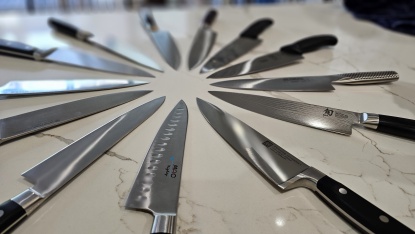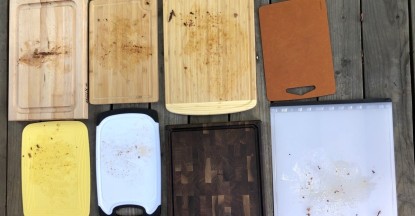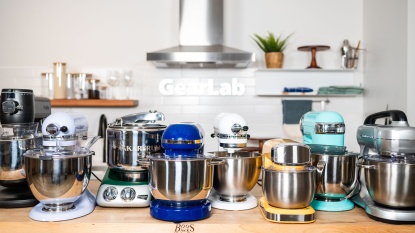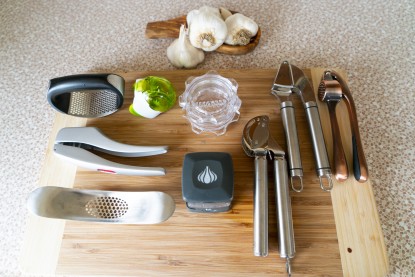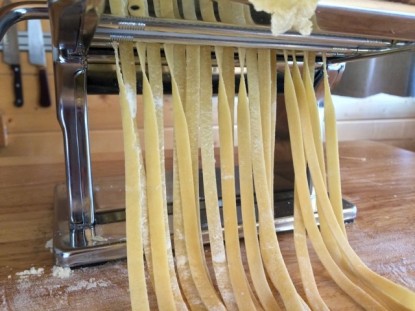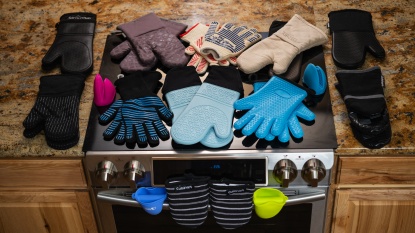A portable pizza oven is a hot item to replace the grill as the focal point of any backyard bash. But do you really need one? Since you're here, we're already assuming that you love pizza. So really, the question is: how do you choose the best pizza oven for your backyard?
Types of Pizza Ovens
Our review features top-ranked pizza ovens of a few different styles, and it is essential to distinguish between them. When we talk about different types of pizza ovens, we're mainly referring to the type of fuel they use. While we put a few electric models through our specific testing protocol, most of this guide will focus on outdoor ovens — these are fired with natural fuels, like wood or charcoal, or propane gas.
Wood-Fired
A wood-fired oven is the only way to make pizza for the traditionalist. The process of cooking bread in a wood-fired oven is as old as our agrarian history, and even the modern wood oven has hardly changed in design since its rise to popularity in Ancient Greece. They are the reliable, timeless option.
Pros- Natural fuel source imparts a distinctive, “wood-fired” flavor
- Under the right conditions, wood is capable of burning hotter than propane
- Simplified design is always reliable
Cons
- Significant learning curve for fire building and baking
- Takes more effort to maintain a fuel source (i.e., splitting logs)
- Smoke and wood-ash means the oven needs to be cleaned more often
Gas-Fired
The next best thing to wood-fired ovens, gas ovens are more popular due to their accessibility. They can quickly recover temperature when cooking multiple pizzas, thanks to their consistent fuel output power. They are a convenient, user-friendly option.
Pros- More convenient to set up and fire by yourself
- Cleaner burning (i.e., no smoke; not necessarily cleaner for the environment)
- Easier temperature control and recovery in between pizzas
Cons
- Propane can be more expensive than wood
- Cooking with gas doesn't afford the same flavor and feel
- Quality of pizza depends on the position and design of the burners
Electric
Electric ovens are your best option if you need to cook inside but still need to cook your own pizzas. Simply put, these are not as fun to use as the outdoor ovens, but they will get the job done — particularly if you are crunched on space.
Pros- Smaller footprint for countertop use
- User-friendly; can be more versatile for other cooking
Cons
- Lower output power doesn't always equal high-quality pizza
- Longer bake times means that it is not as reasonable to make rounds of pizzas
Types of Pizza
As pizza lovers, we all likely have different tastes, style preferences, and favorite local spots to enjoy what we each consider to have great pizza. But before we go any further, it's necessary to point out that most of these outdoor ovens are designed to produce a Neapolitan-style pizza.
Traditional to the Naples region of Italy, this is considered the original style of pizza. Even though you can now find pizza worldwide, this beloved pie has specific attributes, including particular ingredients and cooking techniques. Since 1984, the Associazione Verace Pizza Napoletana (AVPN) has issued an International Regulation on the aspects of a true Neapolitan pizza. As of 2017, the art of Neapolitan pizza making has been recognized by UNESCO as a form of intangible cultural heritage worthy of safeguarding.
But just because these ovens are designed in a Neapolitan style doesn't mean they are relegated to making exclusively one kind of pizza. So ask yourself:
Oven Temperature
When considering the style of pizza, it comes down to the heat of the oven. According to the AVPN, you must fire traditional Neapolitan pizza ovens between 806-896°F to achieve a fully baked pie ready to be cut and eaten in less than 90 seconds. If this is the style of pizza you wish to bake, then having an oven that can reach these temperatures is a must — it is the only way to realize the speedy rise that turns homemade pizza dough into a perfectly puffed, velvety crust.
Neapolitan or NEOpolitan?
Neapolitan pizza, the original pizza, has strict rules for baking temperature and timing. Because this process is speedy, the finished product is often a bit wet in the center. While it isn't an issue in Naples, where an entire pie gets served, uncut, to one person. But Americans aren't usually fans. Enter the Neopolitan pizza. It looks like a Neapolitan but doesn't follow the same rules — stronger American flours are often blended in, and pies are generally baked lower and slower, delivering more crunch and stability in the crust.
For those accustomed to east-coast styles like those found in New Haven or New York — both of which are the most direct descendants of the classic pizza — you still want a hot oven, just not quite as rip-roaring as the traditional Neapolitan furnaces. Both styles require slightly longer cooking times, but the charred bottom of a New Haven apizza develops in an oven hotter than 650°F, while the more foldable New York slice bakes between 500-600°F. The unleavened, cracker-like crust of a St. Louis-style pizza, or the remarkably crunchy Tavern-style pizza from Chicago should both be baked within a temperature range similar to a New York-style pie.
A mention of Tavern-style, or “bar pizza,” is the perfect transition to discussing square styles. A Sicilian pizza — or sfincione — might have more in common with the traditional Ligurian focaccia than it does with the Neapolitan pizza. However, it is still a traditional style that deserves its own spot in the oven. Many of us in the states recognize the thicker, sponge-like crust as a cornerstone of the Detroit-style pizza. Like focaccia, these are baked at lower temperatures — somewhere in the range of 450-550°F — allowing plenty of rising time without burning the base. Another, though likely lesser-known square style is the New England beach pizza whose thinner crust will also benefit from lower temperatures and longer bake times.
Last, but certainly not least, is the hefty Chicago-style deep-dish. A favorite among tourists more than natives — who tend to prefer the more mobile Tavern-style pizza — it is still a popular pie, and certainly in its own category when it comes to preparation and baking. It is best to bake these in your favorite cast iron skillet, and due to the thickness of their filling, these pies require baking times in the range of 30-40 minutes at even lower oven temperature in the range of 400°F.
No Offense…
We don't want to exclude lovers of regional pies like Jersey, Ohio Valley, Quad-City, California, Colorado, or predominantly New England-based Greek-style. But these particular varieties tend to be defined by the toppings or particular preparation. The style of the crust is often too similar to the predominant types to merit their own discussion. Rest assured, any of these styles can be baked at home with the right oven.
Cooking Performance
To avoid getting bogged down in the subjective debate over which style of pizza is the best, let's focus on the attributes of an oven that will allow you to bake a pizza to your ideal standards. Whether you are seeking the traditional wood-fired pillow of a Neapolitan pizza, the crisp chewiness of a New Haven apizza, or an emphatically slow-cooked Chicago-style deep-dish pie, there is an oven for you. Particular design features will help you choose the best oven to cook your perfect pizza.
Cook Time
Instead of concentrating solely on the quality of pizza produced, a subjective issue, we want to examine other considerations like average heating and baking times. The average cook time is directly related to output power (the heat an oven can produce), which, in turn, is related to the size of the oven, construction and insulation, position and quality of the pizza stone, and design of the oven, which determines how the fire actually moves through the oven to bake a pizza.
Since we here at GearLab are far from being true Pizzaiuolo, we take some liberty with the traditional Neapolitan-style. For many of us living outside of Naples, pizza is finger food, not something to be eaten with a knife and fork. For our testing period, we baked pizzas to have a crust that can easily be picked up — not quite the traditional soft crust of a true Neapolitan pizza, but more in-line with the new-world, crispier crust of a New Haven or Neopolitan style pizza. As a result, we recognize that the cook times listed in our reviews will likely be higher than many of the manufacturer's recommendations.
We feel that this is an honest approach to producing what often comes to mind when thinking about “artisanal” pizzas. You should split average cook time into preheating time and baking time — which is the time it takes to actually bake a pizza plus the time it takes the oven to get back up to temperature before it's ready to cook the next one. Regardless of fuel type, all of these ovens tend to reach maximum temperatures with a 15-30 minute preheat. While that is a fairly significant range, we find that differences in preheat timing don't strictly factor into average cooking time because you tend to be prepping dough and ingredients during the preheat time anyway. So let's focus mainly on the second part of this question.
Pizza ovens vary widely in baking time. It is primarily determined by how well they retain heat in both the oven and pizza stone — this is a factor related to insulation, which directly affects the reheat time between loading pizzas. It is also important to note that if you do not continually stoke the fire with a wood-fired oven, it can quickly die down in between firings, which will affect the re-heat time. For this reason, in particular, gas-fired ovens are more convenient, especially if you cannot assign someone to tend the fire constantly. While a hotter oven capable of faster cook times is necessary to nail the Neapolitan style, it's not always what you want. For something like a Sicilian-style pizza, you need a longer cooking time — particularly if you plan on cooking more than one pie. So an important question to ask is:
Output Power
Total power (heat) output is more of an essential factor if you plan to make thinner-crust pizzas baked at more than 600°F. It is simply not possible to produce Neapolitan-style pizzas without a hot oven. If you hope to ever taste the quick-fired magic of these pizzas in your backyard, you are going to need to become comfortable working around open flames and extreme temperatures. However, as we mentioned before, hotter is not always better, depending on the style of pizza you plan on cooking. But as options go, more powerful ovens also tend to operate at lower temperatures, while the opposite is rarely true.
Considering the intensity of the heat of these ovens, average cook times will be significantly less than you may be used to, especially if you have been baking pizzas in a standard, range oven until this point. Most of these ovens average bake times between 2-6 minutes — since you are cooking with temperatures that can push 900°F, working swiftly is a required skill of a Pizzaiuolo. Recognize that these skills take time to learn and that a powerfully hot oven may result in some blackened pizza for those new chefs out there. If that happens, don't be discouraged. Instead, take it as a learning opportunity to adapt the size of the wood fire or regulate the gas output to achieve the desired results. With these new considerations, we can evolve our thought process by combining the previous two questions into one:
It is essential to easily be able to adjust the burner settings on a gas oven. And with a wood-fired oven, you will want to access the fire to either add or break up fuel to adjust the flame. As you fine-tune your culinary practice, consider both the average internal oven temperature and the temperature at the base of the oven (the pizza stone.) The first affects how well your fresh toppings cook, while the second determines how quickly and effectively the crust bakes.
The Pizza Stone
The art of cooking pizza is a balance of achieving the desired crust consistency at the exact moment that the toppings are cooked, and the cheese begins to bubble. To do so, you have to achieve harmony between the conduction heat of the pizza stone and the convective heat of the ambient air temperature inside the oven. The size, thickness, and quality of material used to make the pizza stone and its relative position to the heat source are all going to affect how efficiently and effectively a crust rises and subsequently bakes.
While cranking an oven to its maximum output is the best way to heat a pizza stone, often you have to temper the flame while baking to hit that sweet spot. Ideally, with wood ovens, you are stoking a hot fire to preheat the stone and then only adding a few small pieces of wood to create a rolling flame to provide just enough heat to cook the toppings. Depending on the position of the burners, it may or may not be essential to adjust the burners to harmonize the stone and internal air temperatures to achieve pizza perfection.
Both the internal temperature of the oven and the conduction heat available from the pizza stone are proportional to the heat retention of the oven itself. The more heat an oven can retain, the more consistent the internal temperature is. But many of these ovens — all of the wood-fired options and a number of the gas-fired models — rely on convective heat transfer via rolling flame to heat the pizza stone. Therefore, if an oven is not insulated, not only will it fail to achieve higher-end maximum air temperatures, but it will also take significantly longer for the stone to reheat between pizzas.
Insulation
Indeed, the finished quality of the pizza often comes down to the chef's skill. But in many cases, some ovens consistently produce a better pizza, mainly because they are designed with higher quality insulation. The ability of a powerful oven to preheat quickly may encourage us to bake pizzas amidst the busyness of our daily lives. Still, the capability of a well-insulated oven to maintain heat will allow you to bake rounds of personal pizzas for parties.
Oven insulation will affect everything from preheating and reheating times to maximum potential air and pizza stone temperature to the evenness of the temperature profile and thus consistency of pizza quality. Similar to the question of the number of pizzas, consider how often you plan on using your pizza oven:
- Will I use this oven regularly for personal use?
- Once a week for a family pizza night?
- Or do I want to turn out plentiful pies when it comes time to host a pizza party?
Many of these ovens are designed with double walls and incorporate some form of ceramic fiber insulation. While this modern-style insulation isn't nearly as thick as a traditional pizza oven — and thus will not have nearly the same amount of heat inertia — it does shave off enough weight to make these ovens relatively portable. But if heat retention plays such a significant role in overall performance, why are some ovens designed without doors? This question brings us to our final point, and that's the design of the oven itself.
Oven Design
You will notice that most of the pizza ovens in our review have a very similar design. The domed or vaulted ceiling is an imitation of traditional pizza ovens designed with air circulation in mind. The wood fire at the back draws in air from the front to fuel the flames, which rise and spread out to heat the interior walls of the oven and the cooking surface (pizza stone.) After they are up to temperature, the flames only work to maintain the heat of the walls and ceiling. And instead of fire, it is re-radiated heat from the walls and the conductive heat from the pizza stone that work in harmony to cook the pizza.
The best portable pizza ovens work using the same general principle, though with some modern improvements on design aimed at how airflow directs the flame and heat. Since most of these are insulated enough to retain heat but not necessarily cook via radiation, they have shorter ceilings so that the flames come in closer contact with the pizza. Whether or not they have a chimney tends to follow the lines of fuel source, though this isn't a hard-and-fast rule. All wood-fired ovens will have a chimney to redirect smoke, and the less-insulated gas-fired models (that also require a door to retain heat) will also incorporate a chimney to draw heat toward the front of the oven.
Ease of Use
While cooking performance is the primary point of discussion, it is also essential to consider aspects of user-friendliness — from setup and versatility to the actual act of cooking, all the way through to cleaning. Even though these are specialty ovens, it is nice to know how approachable they are for even the most novice cooks out there.
Setup and Cleaning
Some of these ovens require you to follow a set of instructions to get them out of the box and set up. But when we refer to setup, we're talking about what it takes to get the oven up and running every time you want to make pizza. There are clearly shortcomings here related to wood-fired ovens: these may require fuel prep (if you're going to cook with natural wood) and certainly have a much more involved preheating process that requires both building and stoking the fire, as well as a much more involved baking process that may require someone to constantly monitor the fire — this is particularly true if you want to turn out a large order of pizzas efficiently.
Wood-fired ovens are also more work on the tail-end. Rather than just turning off the propane tank, you must wait for the wood to burn down and then dispose of the remnants. Propane gas burns cleanly, whereas you can expect smoke, ash, and soot from the wood-fire that may require cleaning the oven surface from time to time to prevent build-up — while cleaning, your hands will get covered in black ash and creosote. It is an honest assessment of cooking with a wood fire and not at all meant to dissuade you from buying a wood-fired pizza oven. There is a particular reason why the best Pizzaiuolo in the world cook exclusively with wood-fired ovens — without waxing poetically with flowery language, they simply bake a better pizza.
Accessibility
While wood-fired ovens have traditionally been used for cooking pizzas, they have a fairly demanding learning curve compared to gas-fired options. With wood-fired stoves, not only do you have to learn how to move quickly and efficiently, but there is a whole other art to learning how to build and maintain a fire that will produce the appropriate range of heat — not to mention all the considerations outlined above. Baking wood-fired pizza is indeed an art form, one that is as admirable as it is trendy. But recognize that a gas-fired oven may be a better entry-point, particularly for those new to cooking with natural flame altogether. So consider asking yourself:
Portability
Even though these pizza ovens are marketed as portable, some are much more so than others. Concerning portability, take into account obvious factors like size and weight. But also make sure to look at the footprint of these pizza ovens, which will help you think about where you plan to set it up and where you plan on storing it. Some ovens have design specifics, like foldable legs or a lower profile, enhancing their storage and portability. Also, recognize that depending on where you live — particularly those in apartments or condos — you may not be allowed to use a wood-fired oven that will give off lots of smoke based on the rules and regulations of your complex.
Versatility
While we take versatility into account, it makes up a tiny part of how we look at these ovens. First and foremost, these are, in fact, pizza ovens. But at the same time, we recognize that these are a significant investment, and any potential versatility is a bonus.
Similar to portability questions, versatility is most directly related to size — mainly, the size of the oven chamber and the associated size of the opening. Most can accommodate a skillet or hot tray for roasting; some are large enough to bake long loaves of bread, like a classic Italian loaf or French baguette; others still are tall enough to bake round loaves of bread like boules. But in considering the versatility of an oven, appreciate the fact that most of these portable pizza ovens are simply not designed with the insulation to bake bread with leftover, radiative heat like their more robust residential counterparts.
Conclusion
There's much more to consider here than just baking pizza. With so many options available the options available, sorting through specifications and features can make finding the right pizza oven more complicated than it needs to be. After putting each model through rigorous tests and real-life use, we have built up a wealth of knowledge on the best pizza ovens available today. In conjunction with our in-depth reviews, we hope that this article will help guide you through the selection process.



























